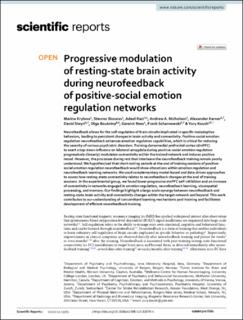| dc.contributor.author | Krylova, Marina | |
| dc.contributor.author | Skouras, Stavros | |
| dc.contributor.author | Razi, Adeel | |
| dc.contributor.author | Nicholson, Andrew A | |
| dc.contributor.author | Karner, Alexander | |
| dc.contributor.author | Steyrl, David | |
| dc.contributor.author | Boukrina, Olga | |
| dc.contributor.author | Rees, Geraint | |
| dc.contributor.author | Scharnowski, Frank | |
| dc.contributor.author | Koush, Yury | |
| dc.date.accessioned | 2022-04-01T08:44:35Z | |
| dc.date.available | 2022-04-01T08:44:35Z | |
| dc.date.created | 2022-02-06T12:49:49Z | |
| dc.date.issued | 2021 | |
| dc.identifier.issn | 2045-2322 | |
| dc.identifier.uri | https://hdl.handle.net/11250/2989147 | |
| dc.description.abstract | Neurofeedback allows for the self-regulation of brain circuits implicated in specific maladaptive behaviors, leading to persistent changes in brain activity and connectivity. Positive-social emotion regulation neurofeedback enhances emotion regulation capabilities, which is critical for reducing the severity of various psychiatric disorders. Training dorsomedial prefrontal cortex (dmPFC) to exert a top-down influence on bilateral amygdala during positive-social emotion regulation progressively (linearly) modulates connectivity within the trained network and induces positive mood. However, the processes during rest that interleave the neurofeedback training remain poorly understood. We hypothesized that short resting periods at the end of training sessions of positive-social emotion regulation neurofeedback would show alterations within emotion regulation and neurofeedback learning networks. We used complementary model-based and data-driven approaches to assess how resting-state connectivity relates to neurofeedback changes at the end of training sessions. In the experimental group, we found lower progressive dmPFC self-inhibition and an increase of connectivity in networks engaged in emotion regulation, neurofeedback learning, visuospatial processing, and memory. Our findings highlight a large-scale synergy between neurofeedback and resting-state brain activity and connectivity changes within the target network and beyond. This work contributes to our understanding of concomitant learning mechanisms post training and facilitates development of efficient neurofeedback training. | en_US |
| dc.language.iso | eng | en_US |
| dc.publisher | Nature Research | en_US |
| dc.rights | Navngivelse 4.0 Internasjonal | * |
| dc.rights.uri | http://creativecommons.org/licenses/by/4.0/deed.no | * |
| dc.title | Progressive modulation of resting‑state brain activity during neurofeedback of positive‑social emotion regulation networks | en_US |
| dc.type | Journal article | en_US |
| dc.type | Peer reviewed | en_US |
| dc.description.version | publishedVersion | en_US |
| dc.rights.holder | Copyright The Author(s) 2021 | en_US |
| dc.source.articlenumber | 23363 | en_US |
| cristin.ispublished | true | |
| cristin.fulltext | original | |
| cristin.qualitycode | 1 | |
| dc.identifier.doi | 10.1038/s41598-021-02079-4 | |
| dc.identifier.cristin | 1998205 | |
| dc.source.journal | Scientific Reports | en_US |
| dc.identifier.citation | Scientific Reports. 2021, 11, 23363. | en_US |
| dc.source.volume | 11 | en_US |

